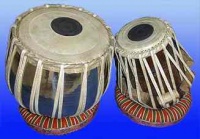Tabla
From SikhiWiki
Jump to navigationJump to search
Soul of Music, the Tabla
The tabla is the most popular percussion instrument used in the classical and popular music of the northern regions of South Asia (Afghanistan, Bangladesh, Nepal, northern India, Pakistan).
The term tabla is an Arabic word which means "drum",The origins of the word tabla come from the arabic word, “tabl,” and this attests to its status as a product resulting from the fusion of musical elements from indigenous Hindu and Central Asian Muslim cultures that began in the late 16th century.
History
- The history of this instrument is at times the subject of heated debate. Reliable historical evidence places the invention of this instrument in the 18th century. Another common historical narrative portrays the tabla as being thousands of years old, yet this is mere conjecture, based on slipshod interpretations of iconography.
- The different traditions of tabla playing go back to the 18th century. The transformation of the tabla from a religious-folk instrument to a more sophisticated instrument of art-music occurred in the late 18th or early 19th centuries, when significant changes took place in the music of North India.
- In public performances, tabla players were primarily accompanists to vocalists and instrumentalists; however, they developed a sophisticated solo repertoire that they performed in their own musical gatherings
The Pair
- The two drums of the tabla are called the dayan and bayan, the names came from the words dayn and baya which mean right and left in hindi.
- The smaller drum, played with the dominant hand, is called the dayan It is made from a conical piece of wood hollowed out to approximately half of its total depth.
- The larger drum, played with the other hand, is called bayan. It is a bowl shape made of metal (or sometimes clay or wood, although not favored for durability). It has a much deeper bass tone.
The Technique
- The playing technique for both drums involves extensive use of the fingers and palms in various configurations to create a wide variety of different sounds. On the bayan the heel of the hand is also used to apply pressure, or in a sliding motion, so that thepitch is changed during the note. This “modulating” effect on the bass drum and the wide range of sounds possible on the instrument as a whole are the main characteristics that make tabla unique among percussion instruments.
- Both drum shells are covered with a head (or puri) constructed from goat or cow skin. This skin is bound together with a complex woven braid that also gives the entire assembly enough strength to be tensioned onto the shell. The completed head construction is fixed to the drum shell with a single continuous piece of cow or camel hide strap laced between the braid of the head assembly and another ring (made from the same strap material) placed on the bottom of the drum. The strap is tensioned to achieve the desired pitch of the drum. Additionally, cylindrical wood blocks are inserted between the strap and the shell allowing the tension to be adjusted by their vertical positioning. Fine tuning is achieved by striking vertically on the braided portion of the head using a small hammer.
See also
- Sikh Kirtan
- Music of Punjab
- Taal
- Saaj - Musical instrument
External links
- Bhai Ajit Singh's site in Spanish on Tabla TablaNaad
- Tabla Lesson for beginners only
- Learn tabla taals
- Tabla lessons by Ustad Jaswinder Singh
| Kirtan: | Raga · Taal · Ragmala · Classical Music · Sangeet · Dhuni · Divan · Asa di Var · Jatha · Simran · Shabad · Tuk · Rababi · Dhadhi |
| Ragas: | Asa · Bairari · Basant · Bhairon · Bihagara · Bilaval · Devagandhari · Dhanasari · Gauri · Gond · Gujari · Jaijavanti · Jaitsri · Kalian · Kanara · Kedara · Maajh · Malaar · Mali Gaura · Maru · Nat Narain · Prabhati · Ramkali · Sarang · Sri · Sorath · Suhi · Tilang · Todi · Tukhari · Vadahans |
| Ragis: | Harjinder Singh · Maninder Singh · Amolak Singh · Darshan Singh · Balwinder Singh · Harbans Singh · Anoop Singh · Niranjan Singh · Amrik Singh · Avtar Singh · Snatam Kaur ·Kamaljit Kaur · Dileep Kaur · Joginder Singh · SS Maskeen |
| Saaj: | Harmonium · Tabla · · Tanpura · Taus · Rabab · Sarangi · Dilruba · · Saranda · Sarode · Sitar · Santoor · Pakhawaj · Dhadh · Dholak · Dool |

